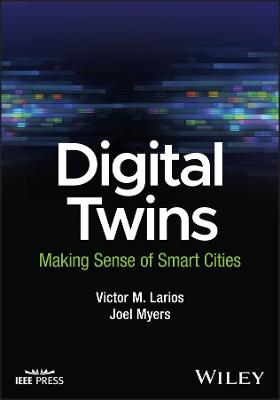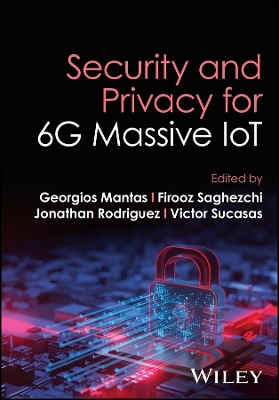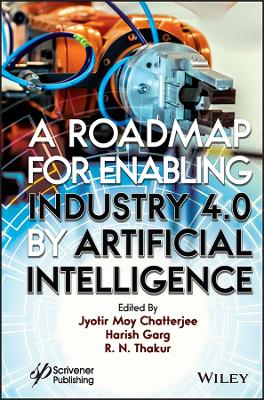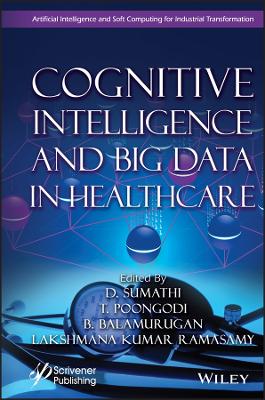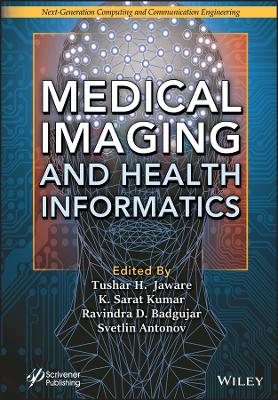Computational Intelligence and Healthcare Informatics
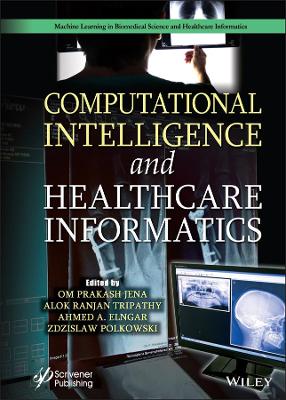 -15%
portes grátis
-15%
portes grátis
Computational Intelligence and Healthcare Informatics
Elngar, Ahmed A.; Tripathy, Alok Ranjan; Polkowski, Zdzislaw; Jena, Om Prakash
John Wiley & Sons Inc
02/2022
432
Dura
Inglês
9781119818687
15 a 20 dias
934
Part I: Introduction 1
1 Machine Learning and Big Data: An Approach Toward Better Healthcare Services 3
Nahid Sami and Asfia Aziz
1.1 Introduction 3
1.2 Machine Learning in Healthcare 4
1.3 Machine Learning Algorithms 6
1.3.1 Supervised Learning 6
1.3.2 Unsupervised Learning 7
1.3.3 Semi-Supervised Learning 7
1.3.4 Reinforcement Learning 8
1.3.5 Deep Learning 8
1.4 Big Data in Healthcare 8
1.5 Application of Big Data in Healthcare 9
1.5.1 Electronic Health Records 9
1.5.2 Helping in Diagnostics 9
1.5.3 Preventive Medicine 10
1.5.4 Precision Medicine 10
1.5.5 Medical Research 10
1.5.6 Cost Reduction 10
1.5.7 Population Health 10
1.5.8 Telemedicine 10
1.5.9 Equipment Maintenance 11
1.5.10 Improved Operational Efficiency 11
1.5.11 Outbreak Prediction 11
1.6 Challenges for Big Data 11
1.7 Conclusion 11
References 12
Part II: Medical Data Processing and Analysis 15
2 Thoracic Image Analysis Using Deep Learning 17
Rakhi Wajgi, Jitendra V. Tembhurne and Dipak Wajgi
2.1 Introduction 18
2.2 Broad Overview of Research 19
2.2.1 Challenges 19
2.2.2 Performance Measuring Parameters 21
2.2.3 Availability of Datasets 21
2.3 Existing Models 23
2.4 Comparison of Existing Models 30
2.5 Summary 38
2.6 Conclusion and Future Scope 38
References 39
3 Feature Selection and Machine Learning Models for High-Dimensional Data: State-of-the-Art 43
G. Manikandan and S. Abirami
3.1 Introduction 43
3.1.1 Motivation of the Dimensionality Reduction 45
3.1.2 Feature Selection and Feature Extraction 46
3.1.3 Objectives of the Feature Selection 47
3.1.4 Feature Selection Process 47
3.2 Types of Feature Selection 48
3.2.1 Filter Methods 49
3.2.1.1 Correlation-Based Feature Selection 49
3.2.1.2 The Fast Correlation-Based Filter 50
3.2.1.3 The INTERACT Algorithm 51
3.2.1.4 ReliefF 51
3.2.1.5 Minimum Redundancy Maximum Relevance 52
3.2.2 Wrapper Methods 52
3.2.3 Embedded Methods 53
3.2.4 Hybrid Methods 54
3.3 Machine Learning and Deep Learning Models 55
3.3.1 Restricted Boltzmann Machine 55
3.3.2 Autoencoder 56
3.3.3 Convolutional Neural Networks 57
3.3.4 Recurrent Neural Network 58
3.4 Real-World Applications and Scenario of Feature Selection 58
3.4.1 Microarray 58
3.4.2 Intrusion Detection 59
3.4.3 Text Categorization 59
3.5 Conclusion 59
References 60
4 A Smart Web Application for Symptom-Based Disease Detection and Prediction Using State-of-the-Art ML and ANN Models 65
Parvej Reja Saleh and Eeshankur Saikia
4.1 Introduction 65
4.2 Literature Review 68
4.3 Dataset, EDA, and Data Processing 69
4.4 Machine Learning Algorithms 72
4.4.1 Multinomial Naive Bayes Classifier 72
4.4.2 Support Vector Machine Classifier 72
4.4.3 Random Forest Classifier 73
4.4.4 K-Nearest Neighbor Classifier 74
4.4.5 Decision Tree Classifier 74
4.4.6 Logistic Regression Classifier 75
4.4.7 Multilayer Perceptron Classifier 76
4.5 Work Architecture 77
4.6 Conclusion 78
References 79
5 Classification of Heart Sound Signals Using Time-Frequency Image Texture Features 81
Sujata Vyas, Mukesh D. Patil and Gajanan K. Birajdar
5.1 Introduction 81
5.1.1 Motivation 82
5.2 Related Work 83
5.3 Theoretical Background 84
5.3.1 Pre-Processing Techniques 84
5.3.2 Spectrogram Generation 85
5.3.2 Feature Extraction 88
5.3.4 Feature Selection 90
5.3.5 Support Vector Machine 91
5.4 Proposed Algorithm 91
5.5 Experimental Results 92
5.5.1 Database 92
5.5.2 Evaluation Metrics 94
5.5.3 Confusion Matrix 94
5.5.4 Results and Discussions 94
5.6 Conclusion 96
References 99
6 Improving Multi-Label Classification in Prototype Selection Scenario 103
Himanshu Suyal and Avtar Singh
6.1 Introduction 103
6.2 Related Work 105
6.3 Methodology 106
6.3.1 Experiments and Evaluation 108
6.4 Performance Evaluation 108
6.5 Experiment Data Set 109
6.6 Experiment Results 110
6.7 Conclusion 117
References 117
7 A Machine Learning-Based Intelligent Computational Framework for the Prediction of Diabetes Disease 121
Maqsood Hayat, Yar Muhammad and Muhammad Tahir
7.1 Introduction 121
7.2 Materials and Methods 123
7.2.1 Dataset 123
7.2.2 Proposed Framework for Diabetes System 124
7.2.3 Pre-Processing of Data 124
7.3 Machine Learning Classification Hypotheses 124
7.3.1 K-Nearest Neighbor 124
7.3.2 Decision Tree 125
7.3.3 Random Forest 126
7.3.4 Logistic Regression 126
7.3.5 Naive Bayes 126
7.3.6 Support Vector Machine 126
7.3.7 Adaptive Boosting 126
7.3.8 Extra-Tree Classifier 127
7.4 Classifier Validation Method 127
7.4.1 K-Fold Cross-Validation Technique 127
7.5 Performance Evaluation Metrics 127
7.6 Results and Discussion 129
7.6.1 Performance of All Classifiers Using 5-Fold CV Method 129
7.6.2 Performance of All Classifiers Using the 7-Fold Cross-Validation Method 131
7.6.3 Performance of All Classifiers Using 10-Fold CV Method 133
7.7 Conclusion 137
References 137
8 Hyperparameter Tuning of Ensemble Classifiers Using Grid Search and Random Search for Prediction of Heart Disease 139
Dhilsath Fathima M. and S. Justin Samuel
8.1 Introduction 140
8.2 Related Work 140
8.3 Proposed Method 142
8.3.1 Dataset Description 143
8.3.2 Ensemble Learners for Classification Modeling 144
8.3.2.1 Bagging Ensemble Learners 145
8.3.2.2 Boosting Ensemble Learner 147
8.3.3 Hyperparameter Tuning of Ensemble Learners 151
8.3.3.1 Grid Search Algorithm 151
8.3.3.2 Random Search Algorithm 152
8.4 Experimental Outcomes and Analyses 153
8.4.1 Characteristics of UCI Heart Disease Dataset 153
8.4.2 Experimental Result of Ensemble Learners and Performance Comparison 154
8.4.3 Analysis of Experimental Result 154
8.5 Conclusion 157
References 157
9 Computational Intelligence and Healthcare Informatics Part III-Recent Development and Advanced Methodologies 159
Sankar Pariserum Perumal, Ganapathy Sannasi, Santhosh Kumar S.V.N. and Kannan Arputharaj
9.1 Introduction: Simulation in Healthcare 160
9.2 Need for a Healthcare Simulation Process 160
9.3 Types of Healthcare Simulations 161
9.4 AI in Healthcare Simulation 163
9.4.1 Machine Learning Models in Healthcare Simulation 163
9.4.1.1 Machine Learning Model for Post-Surgical Risk Prediction 163
9.4.2 Deep Learning Models in Healthcare Simulation 169
9.4.2.1 Bi-LSTM-Based Surgical Participant Prediction Model 170
9.5 Conclusion 174
References 174
10 Wolfram's Cellular Automata Model in Health Informatics 179
Sutapa Sarkar and Mousumi Saha
10.1 Introduction 179
10.2 Cellular Automata 181
10.3 Application of Cellular Automata in Health Science 183
10.4 Cellular Automata in Health Informatics 184
10.5 Health Informatics-Deep Learning-Cellular Automata 190
10.6 Conclusion 191
References 191
Part III: Machine Learning and COVID Prospective 193
11 COVID-19: Classification of Countries for Analysis and Prediction of Global Novel Corona Virus Infections Disease Using Data Mining Techniques 195
Sachin Kamley, Shailesh Jaloree, R.S. Thakur and Kapil Saxena
11.1 Introduction 195
11.2 Literature Review 196
11.3 Data Pre-Processing 197
11.4 Proposed Methodologies 198
11.4.1 Simple Linear Regression 198
11.4.2 Association Rule Mining 202
11.4.3 Back Propagation Neural Network 203
11.5 Experimental Results 204
11.6 Conclusion and Future Scopes 211
References 212
12 Sentiment Analysis on Social Media for Emotional Prediction During COVID-19 Pandemic Using Efficient Machine Learning Approach 215
Sivanantham Kalimuthu
12.1 Introduction 215
12.2 Literature Review 218
12.3 System Design 222
12.3.1 Extracting Feature With WMAR 224
12.4 Result and Discussion 229
12.5 Conclusion 232
References 232
13 Primary Healthcare Model for Remote Area Using Self-Organizing Map Network 235
Sayan Das and Jaya Sil
13.1 Introduction 236
13.2 Background Details and Literature Review 239
13.2.1 Fuzzy Set 239
13.2.2 Self-Organizing Mapping 239
13.3 Methodology 240
13.3.1 Severity_Factor of Patient 244
13.3.2 Clustering by Self-Organizing Mapping 249
13.4 Results and Discussion 250
13.5 Conclusion 252
References 252
14 Face Mask Detection in Real-Time Video Stream Using Deep Learning 255
Alok Negi and Krishan Kumar
14.1 Introduction 256
14.2 Related Work 257
14.3 Proposed Work 258
14.3.1 Dataset Description 258
14.3.2 Data Pre-Processing and Augmentation 258
14.3.3 VGG19 Architecture and Implementation 259
14.3.4 Face Mask Detection From Real-Time Video Stream 261
14.4 Results and Evaluation 262
14.5 Conclusion 267
References 267
15 A Computational Intelligence Approach for Skin Disease Identification Using Machine/Deep Learning Algorithms 269
Swathi Jamjala Narayanan, Pranav Raj Jaiswal, Ariyan Chowdhury, Amitha Maria Joseph and Saurabh Ambar
15.1 Introduction 270
15.2 Research Problem Statements 274
15.3 Dataset Description 274
15.4 Machine Learning Technique Used for Skin Disease Identification 276
15.4.1 Logistic Regression 277
15.4.1.1 Logistic Regression Assumption 277
15.4.1.2 Logistic Sigmoid Function 277
15.4.1.3 Cost Function and Gradient Descent 278
15.4.2 SVM 279
15.4.3 Recurrent Neural Networks 281
15.4.4 Decision Tree Classification Algorithm 283
15.4.5 CNN 286
15.4.6 Random Forest 288
15.5 Result and Analysis 290
15.6 Conclusion 291
References 291
16 Asymptotic Patients' Healthcare Monitoring and Identification of Health Ailments in Post COVID-19 Scenario 297
Pushan K.R. Dutta, Akshay Vinayak and Simran Kumari
16.1 Introduction 298
16.1.1 Motivation 298
16.1.2 Contributions 299
16.1.3 Paper Organization 299
16.1.4 System Model Problem Formulation 299
16.1.5 Proposed Methodology 300
16.2 Material Properties and Design Specifications 301
16.2.1 Hardware Components 301
16.2.1.1 Microcontroller 301
16.2.1.2 ESP8266 Wi-Fi Shield 301
16.2.2 Sensors 301
16.2.2.1 Temperature Sensor (LM 35) 301
16.2.2.2 ECG Sensor (AD8232) 301
16.2.2.3 Pulse Sensor 301
16.2.2.4 GPS Module (NEO 6M V2) 302
16.2.2.5 Gyroscope (GY-521) 302
16.2.3 Software Components 302
16.2.3.1 Arduino Software 302
16.2.3.2 MySQL Database 302
16.2.3.3 Wireless Communication 302
16.3 Experimental Methods and Materials 303
16.3.1 Simulation Environment 303
16.3.1.1 System Hardware 303
16.3.1.2 Connection and Circuitry 304
16.3.1.3 Protocols Used 306
16.3.1.4 Libraries Used 307
16.4 Simulation Results 307
16.5 Conclusion 310
16.6 Abbreviations and Acronyms 310
References 311
17 COVID-19 Detection System Using Cellular Automata-Based Segmentation Techniques 313
Rupashri Barik, M. Nazma B. J. Naskar and Sarbajyoti Mallik
17.1 Introduction 313
17.2 Literature Survey 314
17.2.1 Cellular Automata 315
17.2.2 Image Segmentation 316
17.2.3 Deep Learning Techniques 316
17.3 Proposed Methodology 317
17.4 Results and Discussion 320
17.5 Conclusion 322
References 322
18 Interesting Patterns From COVID-19 Dataset Using Graph-Based Statistical Analysis for Preventive Measures 325
Abhilash C. B. and Kavi Mahesh
18.1 Introduction 326
18.2 Methods 326
18.2.1 Data 326
18.3 GSA Model: Graph-Based Statistical Analysis 327
18.4 Graph-Based Analysis 329
18.4.1 Modeling Your Data as a Graph 329
18.4.2 RDF for Knowledge Graph 331
18.4.3 Knowledge Graph Representation 331
18.4.4 RDF Triple for KaTrace 333
18.4.5 Cipher Query Operation on Knowledge Graph 335
18.4.5.1 Inter-District Travel 335
18.4.5.2 Patient 653 Spread Analysis 336
18.4.5.3 Spread Analysis Using Parent-Child Relationships 337
18.4.5.4 Delhi Congregation Attended the Patient's Analysis 339
18.5 Machine Learning Techniques 339
18.5.1 Apriori Algorithm 339
18.5.2 Decision Tree Classifier 341
18.5.3 System Generated Facts on Pandas 343
18.5.4 Time Series Model 345
18.6 Exploratory Data Analysis 346
18.6.1 Statistical Inference 347
18.7 Conclusion 356
18.8 Limitations 356
Acknowledgments 356
Abbreviations 357
References 357
Part IV: Prospective of Computational Intelligence in Healthcare 359
19 Conceptualizing Tomorrow's Healthcare Through Digitization 361
Riddhi Chatterjee, Ratula Ray, Satya Ranjan Dash and Om Prakash Jena
19.1 Introduction 361
19.2 Importance of IoMT in Healthcare 362
19.3 Case Study I: An Integrated Telemedicine Platform in Wake of the COVID-19 Crisis 363
19.3.1 Introduction to the Case Study 363
19.3.2 Merits 363
19.3.3 Proposed Design 363
19.3.3.1 Homecare 363
19.3.3.2 Healthcare Provider 365
19.3.3.3 Community 367
19.4 Case Study II: A Smart Sleep Detection System to Track the Sleeping Pattern in Patients Suffering From Sleep Apnea 371
19.4.1 Introduction to the Case Study 371
19.4.2 Proposed Design 373
19.5 Future of Smart Healthcare 375
19.6 Conclusion 375
References 375
20 Domain Adaptation of Parts of Speech Annotators in Hindi Biomedical Corpus: An NLP Approach 377
Pitambar Behera and Om Prakash Jena
20.1 Introduction 377
20.1.1 COVID-19 Pandemic Situation 378
20.1.2 Salient Characteristics of Biomedical Corpus 378
20.2 Review of Related Literature 379
20.2.1 Biomedical NLP Research 379
20.2.2 Domain Adaptation 379
20.2.3 POS Tagging in Hindi 380
20.3 Scope and Objectives 380
20.3.1 Research Questions 380
20.3.2 Research Problem 380
20.3.3 Objectives 381
20.4 Methodological Design 381
20.4.1 Method of Data Collection 381
20.4.2 Method of Data Annotation 381
20.4.2.1 The BIS Tagset 381
20.4.2.2 ILCI Semi-Automated Annotation Tool 382
20.4.2.3 IA Agreement 383
20.4.3 Method of Data Analysis 383
20.4.3.1 The Theory of Support Vector Machines 384
20.4.3.2 Experimental Setup 384
20.5 Evaluation 385
20.5.1 Error Analysis 386
20.5.2 Fleiss' Kappa 388
20.6 Issues 388
20.7 Conclusion and Future Work 388
Acknowledgements 389
References 389
21 Application of Natural Language Processing in Healthcare 393
Khushi Roy, Subhra Debdas, Sayantan Kundu, Shalini Chouhan, Shivangi Mohanty and Biswarup Biswas
21.1 Introduction 393
21.2 Evolution of Natural Language Processing 395
21.3 Outline of NLP in Medical Management 396
21.4 Levels of Natural Language Processing in Healthcare 397
21.5 Opportunities and Challenges From a Clinical Perspective 399
21.5.1 Application of Natural Language Processing in the Field of Medical Health Records 399
21.5.2 Using Natural Language Processing for Large-Sample Clinical Research 400
21.6 Openings and Difficulties From a Natural Language Processing Point of View 401
21.6.1 Methods for Developing Shareable Data 401
21.6.2 Intrinsic Evaluation and Representation Levels 402
21.6.3 Beyond Electronic Health Record Data 403
21.7 Actionable Guidance and Directions for the Future 403
21.8 Conclusion 406
References 406
Index 409
Part I: Introduction 1
1 Machine Learning and Big Data: An Approach Toward Better Healthcare Services 3
Nahid Sami and Asfia Aziz
1.1 Introduction 3
1.2 Machine Learning in Healthcare 4
1.3 Machine Learning Algorithms 6
1.3.1 Supervised Learning 6
1.3.2 Unsupervised Learning 7
1.3.3 Semi-Supervised Learning 7
1.3.4 Reinforcement Learning 8
1.3.5 Deep Learning 8
1.4 Big Data in Healthcare 8
1.5 Application of Big Data in Healthcare 9
1.5.1 Electronic Health Records 9
1.5.2 Helping in Diagnostics 9
1.5.3 Preventive Medicine 10
1.5.4 Precision Medicine 10
1.5.5 Medical Research 10
1.5.6 Cost Reduction 10
1.5.7 Population Health 10
1.5.8 Telemedicine 10
1.5.9 Equipment Maintenance 11
1.5.10 Improved Operational Efficiency 11
1.5.11 Outbreak Prediction 11
1.6 Challenges for Big Data 11
1.7 Conclusion 11
References 12
Part II: Medical Data Processing and Analysis 15
2 Thoracic Image Analysis Using Deep Learning 17
Rakhi Wajgi, Jitendra V. Tembhurne and Dipak Wajgi
2.1 Introduction 18
2.2 Broad Overview of Research 19
2.2.1 Challenges 19
2.2.2 Performance Measuring Parameters 21
2.2.3 Availability of Datasets 21
2.3 Existing Models 23
2.4 Comparison of Existing Models 30
2.5 Summary 38
2.6 Conclusion and Future Scope 38
References 39
3 Feature Selection and Machine Learning Models for High-Dimensional Data: State-of-the-Art 43
G. Manikandan and S. Abirami
3.1 Introduction 43
3.1.1 Motivation of the Dimensionality Reduction 45
3.1.2 Feature Selection and Feature Extraction 46
3.1.3 Objectives of the Feature Selection 47
3.1.4 Feature Selection Process 47
3.2 Types of Feature Selection 48
3.2.1 Filter Methods 49
3.2.1.1 Correlation-Based Feature Selection 49
3.2.1.2 The Fast Correlation-Based Filter 50
3.2.1.3 The INTERACT Algorithm 51
3.2.1.4 ReliefF 51
3.2.1.5 Minimum Redundancy Maximum Relevance 52
3.2.2 Wrapper Methods 52
3.2.3 Embedded Methods 53
3.2.4 Hybrid Methods 54
3.3 Machine Learning and Deep Learning Models 55
3.3.1 Restricted Boltzmann Machine 55
3.3.2 Autoencoder 56
3.3.3 Convolutional Neural Networks 57
3.3.4 Recurrent Neural Network 58
3.4 Real-World Applications and Scenario of Feature Selection 58
3.4.1 Microarray 58
3.4.2 Intrusion Detection 59
3.4.3 Text Categorization 59
3.5 Conclusion 59
References 60
4 A Smart Web Application for Symptom-Based Disease Detection and Prediction Using State-of-the-Art ML and ANN Models 65
Parvej Reja Saleh and Eeshankur Saikia
4.1 Introduction 65
4.2 Literature Review 68
4.3 Dataset, EDA, and Data Processing 69
4.4 Machine Learning Algorithms 72
4.4.1 Multinomial Naive Bayes Classifier 72
4.4.2 Support Vector Machine Classifier 72
4.4.3 Random Forest Classifier 73
4.4.4 K-Nearest Neighbor Classifier 74
4.4.5 Decision Tree Classifier 74
4.4.6 Logistic Regression Classifier 75
4.4.7 Multilayer Perceptron Classifier 76
4.5 Work Architecture 77
4.6 Conclusion 78
References 79
5 Classification of Heart Sound Signals Using Time-Frequency Image Texture Features 81
Sujata Vyas, Mukesh D. Patil and Gajanan K. Birajdar
5.1 Introduction 81
5.1.1 Motivation 82
5.2 Related Work 83
5.3 Theoretical Background 84
5.3.1 Pre-Processing Techniques 84
5.3.2 Spectrogram Generation 85
5.3.2 Feature Extraction 88
5.3.4 Feature Selection 90
5.3.5 Support Vector Machine 91
5.4 Proposed Algorithm 91
5.5 Experimental Results 92
5.5.1 Database 92
5.5.2 Evaluation Metrics 94
5.5.3 Confusion Matrix 94
5.5.4 Results and Discussions 94
5.6 Conclusion 96
References 99
6 Improving Multi-Label Classification in Prototype Selection Scenario 103
Himanshu Suyal and Avtar Singh
6.1 Introduction 103
6.2 Related Work 105
6.3 Methodology 106
6.3.1 Experiments and Evaluation 108
6.4 Performance Evaluation 108
6.5 Experiment Data Set 109
6.6 Experiment Results 110
6.7 Conclusion 117
References 117
7 A Machine Learning-Based Intelligent Computational Framework for the Prediction of Diabetes Disease 121
Maqsood Hayat, Yar Muhammad and Muhammad Tahir
7.1 Introduction 121
7.2 Materials and Methods 123
7.2.1 Dataset 123
7.2.2 Proposed Framework for Diabetes System 124
7.2.3 Pre-Processing of Data 124
7.3 Machine Learning Classification Hypotheses 124
7.3.1 K-Nearest Neighbor 124
7.3.2 Decision Tree 125
7.3.3 Random Forest 126
7.3.4 Logistic Regression 126
7.3.5 Naive Bayes 126
7.3.6 Support Vector Machine 126
7.3.7 Adaptive Boosting 126
7.3.8 Extra-Tree Classifier 127
7.4 Classifier Validation Method 127
7.4.1 K-Fold Cross-Validation Technique 127
7.5 Performance Evaluation Metrics 127
7.6 Results and Discussion 129
7.6.1 Performance of All Classifiers Using 5-Fold CV Method 129
7.6.2 Performance of All Classifiers Using the 7-Fold Cross-Validation Method 131
7.6.3 Performance of All Classifiers Using 10-Fold CV Method 133
7.7 Conclusion 137
References 137
8 Hyperparameter Tuning of Ensemble Classifiers Using Grid Search and Random Search for Prediction of Heart Disease 139
Dhilsath Fathima M. and S. Justin Samuel
8.1 Introduction 140
8.2 Related Work 140
8.3 Proposed Method 142
8.3.1 Dataset Description 143
8.3.2 Ensemble Learners for Classification Modeling 144
8.3.2.1 Bagging Ensemble Learners 145
8.3.2.2 Boosting Ensemble Learner 147
8.3.3 Hyperparameter Tuning of Ensemble Learners 151
8.3.3.1 Grid Search Algorithm 151
8.3.3.2 Random Search Algorithm 152
8.4 Experimental Outcomes and Analyses 153
8.4.1 Characteristics of UCI Heart Disease Dataset 153
8.4.2 Experimental Result of Ensemble Learners and Performance Comparison 154
8.4.3 Analysis of Experimental Result 154
8.5 Conclusion 157
References 157
9 Computational Intelligence and Healthcare Informatics Part III-Recent Development and Advanced Methodologies 159
Sankar Pariserum Perumal, Ganapathy Sannasi, Santhosh Kumar S.V.N. and Kannan Arputharaj
9.1 Introduction: Simulation in Healthcare 160
9.2 Need for a Healthcare Simulation Process 160
9.3 Types of Healthcare Simulations 161
9.4 AI in Healthcare Simulation 163
9.4.1 Machine Learning Models in Healthcare Simulation 163
9.4.1.1 Machine Learning Model for Post-Surgical Risk Prediction 163
9.4.2 Deep Learning Models in Healthcare Simulation 169
9.4.2.1 Bi-LSTM-Based Surgical Participant Prediction Model 170
9.5 Conclusion 174
References 174
10 Wolfram's Cellular Automata Model in Health Informatics 179
Sutapa Sarkar and Mousumi Saha
10.1 Introduction 179
10.2 Cellular Automata 181
10.3 Application of Cellular Automata in Health Science 183
10.4 Cellular Automata in Health Informatics 184
10.5 Health Informatics-Deep Learning-Cellular Automata 190
10.6 Conclusion 191
References 191
Part III: Machine Learning and COVID Prospective 193
11 COVID-19: Classification of Countries for Analysis and Prediction of Global Novel Corona Virus Infections Disease Using Data Mining Techniques 195
Sachin Kamley, Shailesh Jaloree, R.S. Thakur and Kapil Saxena
11.1 Introduction 195
11.2 Literature Review 196
11.3 Data Pre-Processing 197
11.4 Proposed Methodologies 198
11.4.1 Simple Linear Regression 198
11.4.2 Association Rule Mining 202
11.4.3 Back Propagation Neural Network 203
11.5 Experimental Results 204
11.6 Conclusion and Future Scopes 211
References 212
12 Sentiment Analysis on Social Media for Emotional Prediction During COVID-19 Pandemic Using Efficient Machine Learning Approach 215
Sivanantham Kalimuthu
12.1 Introduction 215
12.2 Literature Review 218
12.3 System Design 222
12.3.1 Extracting Feature With WMAR 224
12.4 Result and Discussion 229
12.5 Conclusion 232
References 232
13 Primary Healthcare Model for Remote Area Using Self-Organizing Map Network 235
Sayan Das and Jaya Sil
13.1 Introduction 236
13.2 Background Details and Literature Review 239
13.2.1 Fuzzy Set 239
13.2.2 Self-Organizing Mapping 239
13.3 Methodology 240
13.3.1 Severity_Factor of Patient 244
13.3.2 Clustering by Self-Organizing Mapping 249
13.4 Results and Discussion 250
13.5 Conclusion 252
References 252
14 Face Mask Detection in Real-Time Video Stream Using Deep Learning 255
Alok Negi and Krishan Kumar
14.1 Introduction 256
14.2 Related Work 257
14.3 Proposed Work 258
14.3.1 Dataset Description 258
14.3.2 Data Pre-Processing and Augmentation 258
14.3.3 VGG19 Architecture and Implementation 259
14.3.4 Face Mask Detection From Real-Time Video Stream 261
14.4 Results and Evaluation 262
14.5 Conclusion 267
References 267
15 A Computational Intelligence Approach for Skin Disease Identification Using Machine/Deep Learning Algorithms 269
Swathi Jamjala Narayanan, Pranav Raj Jaiswal, Ariyan Chowdhury, Amitha Maria Joseph and Saurabh Ambar
15.1 Introduction 270
15.2 Research Problem Statements 274
15.3 Dataset Description 274
15.4 Machine Learning Technique Used for Skin Disease Identification 276
15.4.1 Logistic Regression 277
15.4.1.1 Logistic Regression Assumption 277
15.4.1.2 Logistic Sigmoid Function 277
15.4.1.3 Cost Function and Gradient Descent 278
15.4.2 SVM 279
15.4.3 Recurrent Neural Networks 281
15.4.4 Decision Tree Classification Algorithm 283
15.4.5 CNN 286
15.4.6 Random Forest 288
15.5 Result and Analysis 290
15.6 Conclusion 291
References 291
16 Asymptotic Patients' Healthcare Monitoring and Identification of Health Ailments in Post COVID-19 Scenario 297
Pushan K.R. Dutta, Akshay Vinayak and Simran Kumari
16.1 Introduction 298
16.1.1 Motivation 298
16.1.2 Contributions 299
16.1.3 Paper Organization 299
16.1.4 System Model Problem Formulation 299
16.1.5 Proposed Methodology 300
16.2 Material Properties and Design Specifications 301
16.2.1 Hardware Components 301
16.2.1.1 Microcontroller 301
16.2.1.2 ESP8266 Wi-Fi Shield 301
16.2.2 Sensors 301
16.2.2.1 Temperature Sensor (LM 35) 301
16.2.2.2 ECG Sensor (AD8232) 301
16.2.2.3 Pulse Sensor 301
16.2.2.4 GPS Module (NEO 6M V2) 302
16.2.2.5 Gyroscope (GY-521) 302
16.2.3 Software Components 302
16.2.3.1 Arduino Software 302
16.2.3.2 MySQL Database 302
16.2.3.3 Wireless Communication 302
16.3 Experimental Methods and Materials 303
16.3.1 Simulation Environment 303
16.3.1.1 System Hardware 303
16.3.1.2 Connection and Circuitry 304
16.3.1.3 Protocols Used 306
16.3.1.4 Libraries Used 307
16.4 Simulation Results 307
16.5 Conclusion 310
16.6 Abbreviations and Acronyms 310
References 311
17 COVID-19 Detection System Using Cellular Automata-Based Segmentation Techniques 313
Rupashri Barik, M. Nazma B. J. Naskar and Sarbajyoti Mallik
17.1 Introduction 313
17.2 Literature Survey 314
17.2.1 Cellular Automata 315
17.2.2 Image Segmentation 316
17.2.3 Deep Learning Techniques 316
17.3 Proposed Methodology 317
17.4 Results and Discussion 320
17.5 Conclusion 322
References 322
18 Interesting Patterns From COVID-19 Dataset Using Graph-Based Statistical Analysis for Preventive Measures 325
Abhilash C. B. and Kavi Mahesh
18.1 Introduction 326
18.2 Methods 326
18.2.1 Data 326
18.3 GSA Model: Graph-Based Statistical Analysis 327
18.4 Graph-Based Analysis 329
18.4.1 Modeling Your Data as a Graph 329
18.4.2 RDF for Knowledge Graph 331
18.4.3 Knowledge Graph Representation 331
18.4.4 RDF Triple for KaTrace 333
18.4.5 Cipher Query Operation on Knowledge Graph 335
18.4.5.1 Inter-District Travel 335
18.4.5.2 Patient 653 Spread Analysis 336
18.4.5.3 Spread Analysis Using Parent-Child Relationships 337
18.4.5.4 Delhi Congregation Attended the Patient's Analysis 339
18.5 Machine Learning Techniques 339
18.5.1 Apriori Algorithm 339
18.5.2 Decision Tree Classifier 341
18.5.3 System Generated Facts on Pandas 343
18.5.4 Time Series Model 345
18.6 Exploratory Data Analysis 346
18.6.1 Statistical Inference 347
18.7 Conclusion 356
18.8 Limitations 356
Acknowledgments 356
Abbreviations 357
References 357
Part IV: Prospective of Computational Intelligence in Healthcare 359
19 Conceptualizing Tomorrow's Healthcare Through Digitization 361
Riddhi Chatterjee, Ratula Ray, Satya Ranjan Dash and Om Prakash Jena
19.1 Introduction 361
19.2 Importance of IoMT in Healthcare 362
19.3 Case Study I: An Integrated Telemedicine Platform in Wake of the COVID-19 Crisis 363
19.3.1 Introduction to the Case Study 363
19.3.2 Merits 363
19.3.3 Proposed Design 363
19.3.3.1 Homecare 363
19.3.3.2 Healthcare Provider 365
19.3.3.3 Community 367
19.4 Case Study II: A Smart Sleep Detection System to Track the Sleeping Pattern in Patients Suffering From Sleep Apnea 371
19.4.1 Introduction to the Case Study 371
19.4.2 Proposed Design 373
19.5 Future of Smart Healthcare 375
19.6 Conclusion 375
References 375
20 Domain Adaptation of Parts of Speech Annotators in Hindi Biomedical Corpus: An NLP Approach 377
Pitambar Behera and Om Prakash Jena
20.1 Introduction 377
20.1.1 COVID-19 Pandemic Situation 378
20.1.2 Salient Characteristics of Biomedical Corpus 378
20.2 Review of Related Literature 379
20.2.1 Biomedical NLP Research 379
20.2.2 Domain Adaptation 379
20.2.3 POS Tagging in Hindi 380
20.3 Scope and Objectives 380
20.3.1 Research Questions 380
20.3.2 Research Problem 380
20.3.3 Objectives 381
20.4 Methodological Design 381
20.4.1 Method of Data Collection 381
20.4.2 Method of Data Annotation 381
20.4.2.1 The BIS Tagset 381
20.4.2.2 ILCI Semi-Automated Annotation Tool 382
20.4.2.3 IA Agreement 383
20.4.3 Method of Data Analysis 383
20.4.3.1 The Theory of Support Vector Machines 384
20.4.3.2 Experimental Setup 384
20.5 Evaluation 385
20.5.1 Error Analysis 386
20.5.2 Fleiss' Kappa 388
20.6 Issues 388
20.7 Conclusion and Future Work 388
Acknowledgements 389
References 389
21 Application of Natural Language Processing in Healthcare 393
Khushi Roy, Subhra Debdas, Sayantan Kundu, Shalini Chouhan, Shivangi Mohanty and Biswarup Biswas
21.1 Introduction 393
21.2 Evolution of Natural Language Processing 395
21.3 Outline of NLP in Medical Management 396
21.4 Levels of Natural Language Processing in Healthcare 397
21.5 Opportunities and Challenges From a Clinical Perspective 399
21.5.1 Application of Natural Language Processing in the Field of Medical Health Records 399
21.5.2 Using Natural Language Processing for Large-Sample Clinical Research 400
21.6 Openings and Difficulties From a Natural Language Processing Point of View 401
21.6.1 Methods for Developing Shareable Data 401
21.6.2 Intrinsic Evaluation and Representation Levels 402
21.6.3 Beyond Electronic Health Record Data 403
21.7 Actionable Guidance and Directions for the Future 403
21.8 Conclusion 406
References 406
Index 409

